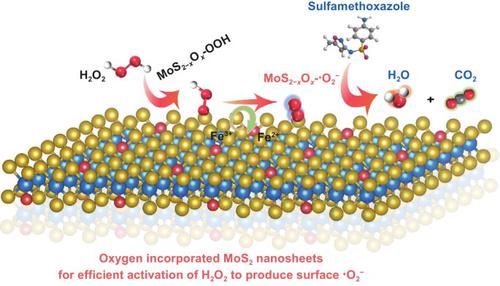Nano Research ( IF 9.9 ) Pub Date : 2021-09-09 , DOI: 10.1007/s12274-021-3848-3 Xianjun Tan 1 , Wenhui Ding 1 , Zhenying Jiang 1 , Linxiao Sun 1 , Yuxiong Huang 1

|
To better understand the mechanisms of hydrogen peroxide (H2O2)’s decomposition and reactive oxygen species (ROS)’s formation on the catalyst’s surface is always a critical issue for the environmental application of Fenton/Fenton-like reaction. We here report a new approach to activate H2O2 in a co-catalytic Fenton system with oxygen incorporated MoS2, namely MoS2−xOx nanosheets. The MoS2−xOx nanosheets assisted co-catalytic Fenton system exhibited superior degradation activity of emerging antibiotic contaminants (e.g., sulfamethoxazole). Combining density functional theory (DFT) calculation and experimental investigation, we demonstrated that oxygen incorporation could improve the intrinsic conductivity of MoS2−xOx nanosheets and accelerate surface/interfacial charge transfer, which further leads to the efficacious activation of H2O2. Moreover, by tuning the oxygen proportion in MoS2−xOx nanosheets, we are able to modulate the generation of ROS and further direct the oriented-conversion of H2O2 to surface-bounded superoxide radical (·O2 surface−). It sheds light on the generation and transformation of ROS in the engineered system (e.g., Fenton, Fenton-like reaction) for efficient degradation of persistent pollutants.
中文翻译:

重塑 MoS2 共催化芬顿反应:氧结合介导表面超氧自由基生成
更好地理解过氧化氢 (H 2 O 2 ) 分解和活性氧 (ROS) 在催化剂表面形成的机制一直是芬顿/类芬顿反应环境应用的关键问题。我们在此报告了一种在共催化 Fenton 系统中激活 H 2 O 2的新方法,其中氧掺入了 MoS 2,即 MoS 2- x O x纳米片。MoS 2− x O x纳米片辅助的共催化芬顿系统对新兴抗生素污染物(例如磺胺甲恶唑)表现出优异的降解活性。结合密度泛函理论 (DFT) 计算和实验研究,我们证明氧掺入可以提高 MoS 2− x O x纳米片的固有电导率并加速表面/界面电荷转移,从而进一步导致 H 2 O 2的有效活化. 此外,通过调节 MoS 2− x O x纳米片中的氧比例,我们能够调节 ROS 的产生并进一步指导 H 2 O 2的定向转化到表面结合的超氧自由基(·O 2 表面-)。它阐明了工程系统(例如芬顿、类芬顿反应)中 ROS 的产生和转化,以有效降解持久性污染物。


























 京公网安备 11010802027423号
京公网安备 11010802027423号